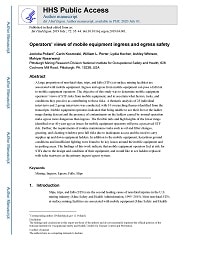Mining Publication: Operators' Views of Mobile Equipment Ingress and Egress Safety
Original creation date: July 2020
Authors: J Pollard, C Kosmoski, W Porter, L Kocher, A Whitson, M Nasarwanji
A large proportion of non-fatal slips, trips, and falls (STFs) at surface mining facilities are associated with mobile equipment. Ingress and egress from mobile equipment can pose a fall risk to mobile equipment operators. The objective of this study was to determine mobile equipment operators’ views of STF risks from mobile equipment, and to ascertain what factors, tasks, and conditions they perceive as contributing to these risks. A thematic analysis of 23 individual interviews and 2 group interviews was conducted, with 10 overarching themes identified from the transcripts. Mobile equipment operators indicated that being unable to see their feet or the ladder rungs during descent and the presence of contaminants on the ladders caused by normal operation make egress more dangerous than ingress. The flexible rails and high heights of the lower rungs identified over 40 years ago as issues for mobile equipment operators still pose a perceived STF risk. Further, the requirements of routine maintenance tasks such as oil and filter changes, greasing, and cleaning windows pose fall risks due to inadequate access and the need to carry supplies up and down equipment ladders. In addition to the mobile equipment, hazardous ground conditions and insufficient lighting were found to be key issues around the mobile equipment and in parking areas. The findings of this work indicate that mobile equipment operators feel at risk for STFs due to the design and condition of their equipment, and would like to see ladders replaced with safer stairways as the primary ingress/egress system.

- An Analysis of Injuries to Front-end Loader Operators During Ingress and Egress
- Contributing Factors to Slip, Trip, and Fall Fatalities at Surface Coal and Metal/Nonmetal Mines
- Designing Safe Mobile Equipment Access Areas
- The Effect of Cap Lamp Lighting on Postural Control and Stability
- Investigation of a Slip/Fall Accident
- Preventing Slips, Trips and Falls from Front-end Loaders
- Slip Potential for Commonly Used Inclined Grated Metal Walkways
- Slip, Trip, and Fall Hazard Identification, Investigation, and Remediation at Surface Mining Facilities
- Visual Performance for Trip Hazard Detection When Using Incandescent and LED Miner Cap Lamps
- When Work Boots Wear Out